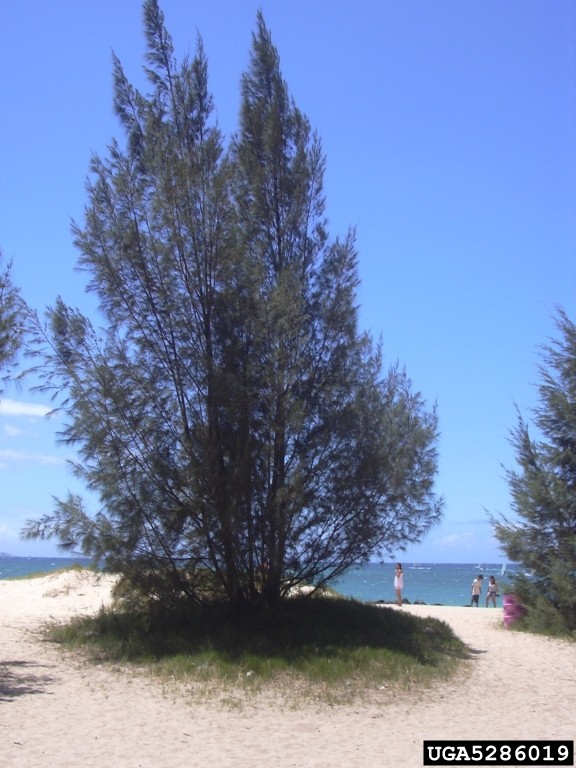Casuarina equisetifolia
Australian pine
Synonym: Casuarina litorea, C.littorea
Class: Magnoliopsida
Order: Casuarinales
Family: Casuarinaceae

Photographer: Forest and Kim Starr, Starr Environmental
Source: Bugwood.org
Description
The Australian pine, Casuarina equisetifolia, is a deciduous tree with a wispy pine-like appearance that can grow up to 100 feet in height. Even though it is not an actual conifer (Pinus sp.) it has cone-like fruit and leaves that resemble pine needles. Its flowers are tiny, brown and wind-pollinated. The fruit is a nutlet that is about .5 inch in diameter and it contains the winged seeds.
Ecological Threat: Casuarina equisetifolia is a fast growing tree that changes habitat, outcompetes native species, and contributes to soil erosion. Dense thickets displaces native dune and beach vegetation by changing the light, temperature, soil chemistry and hydrology of the habitat. The leaf litter has allelopathic properties, while it covers the ground it inhibits the growth of other plants. The pollen causes strong respiratory allergic reactions. This tree offers no wildlife habitat, is displaces native songbirds except for migrating goldfinches that feed on the seeds. It also destroys breeding sites of threatened or endangered species in the Everglades; particularly nesting sites of the American crocodile. Nesting sites for the green sea turtle, gopher tortoise and loggerhead turtle are at risk also because baby turtles can get trapped in the maze that is their shallow root system. The root system can also break sewer and water lines and break pavement.
Biology: The Australian pine reproduces both sexually and vegetatively. Most trees in the continental United States flower twice a year from February to April and September to October. Fruit matures in June and December. After about 5 years of growth, each tree produces thousands of winged seeds, which can be dispersed by birds, animals, water and wind. Seeds usually germinate within 4-8 days but can remain viable for up to a year. Seedlings are sensitive to fire, drought, flooding and are intolerant of shade, and can be outcompeted by grasses and sedges.
History: In 1898 the USDA introduced seeds of Australian pine to Florida for stabilization of ditch and canal banks, and to be used as timber. Before 1920 the tree was naturalized in Florida and the West Indies.
U.S. Habitat: Primarily in tropical and subtropical climates in coastal habitats, such as beaches and estuaries. Frequently found on disturbed sites, and can occupy poor soils and several types of substrates; but does not do well in heavy, clay soils.
Distribution
Native Origin: Australia, New Guinea, Borneo, Indonesia and the Philippines
U.S. Present: AL, AZ, CA, FL, HI, PR and TX
Resembles/Alternatives
It bears a superficial resemble to the conifer genus Pinus because of the small cone-like fruits and the scale-like leaves that look like pine needles. It also resembles other Casuarina species, like the Australian river oak and Brazilian oak, which are also invasive species in Florida. The Australian pine is known to hybridize with the other two species, creating trees with intermediate characteristics that are difficult to identify.
Management
Cutting or damage to the tree induces vegetative growth, so it is an ineffective management strategy. Repeat burning of large mono-specific stands, combined with herbicide use on re-sprouts, may be used for trees greater than 3 in. in diameter. Unfortunately, fire can also make the soils too alkaline, making it unsuitable for native plant growth. As far as herbicides go, Triclopyr works well on foliage and glyphosate are best for cut surfaces. Tests are being conducted to find a suitable biological control for this invasive species. Some of the potential biological controls are a defoliating moth from Australia (Zauclophora pelodes) and a host-specific seed-feeding wasp (Bootanelleus orientalis); also a root rot that is present in Florida (Clitocybe tabescens) can infect over 200 plant species and could be used against Australian pine.
References
Woodward, Susan L., and Joyce Ann. Quinn. 2011. Australian Tree. Encyclopedia of Invasive Species: From Africanized Honey Bees to Zebra Mussels. Santa Barbara, CA: Greenwood. 540-44. Print.
Internet References
http://www.nps.gov/plants/alien/fact/caeq1.htm
http://www.tbep.org/isteachersguide/PDF/AustralianPine.pdf
http://plants.ifas.ufl.edu/node/18
http://www.waspweb.org/Chalcidoidea/Torymidae/Megastigminae/Classification/index.htm
http://wiki.bugwood.org/Archive:Cottonwood/Clitocybe_tabescens
http://xyloryctinemothsofaustralia.blogspot.com/2010/06/zauclophora.html
 Texas Invasive Species Institute
Texas Invasive Species Institute